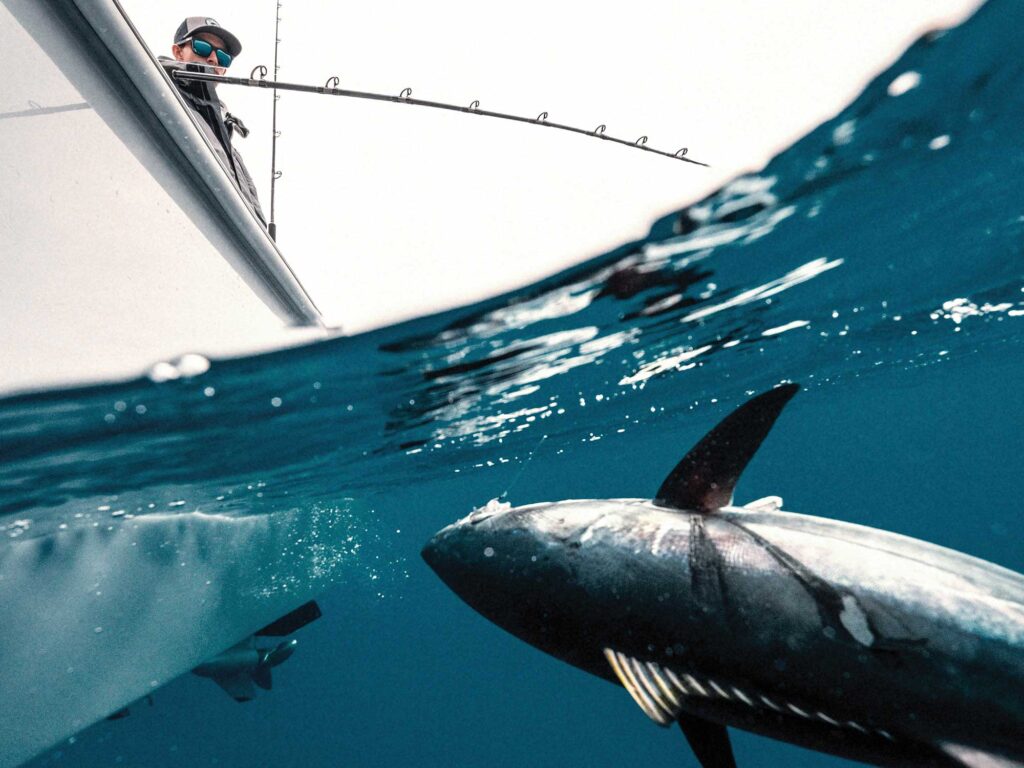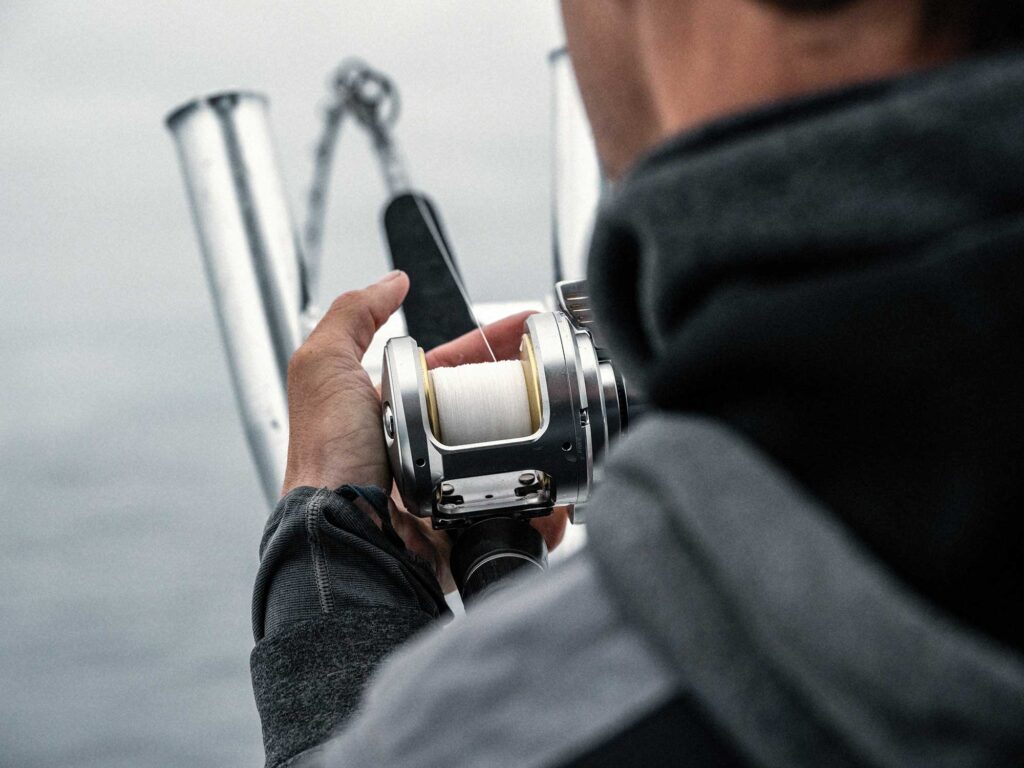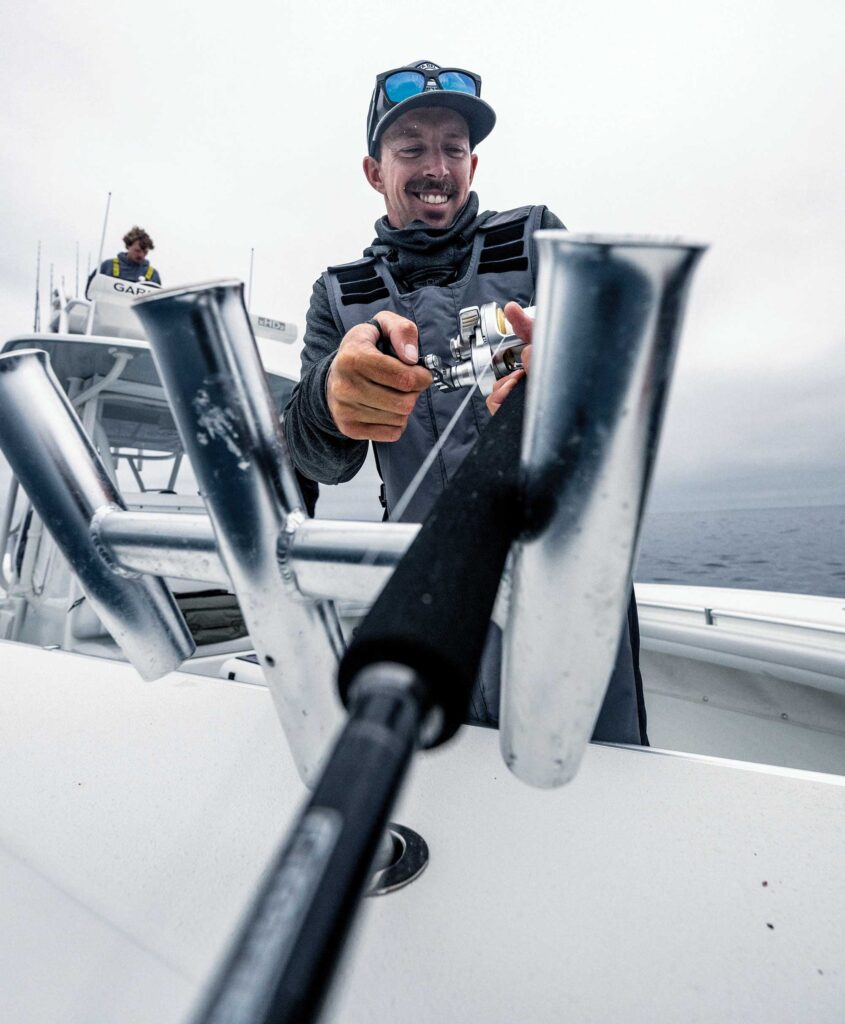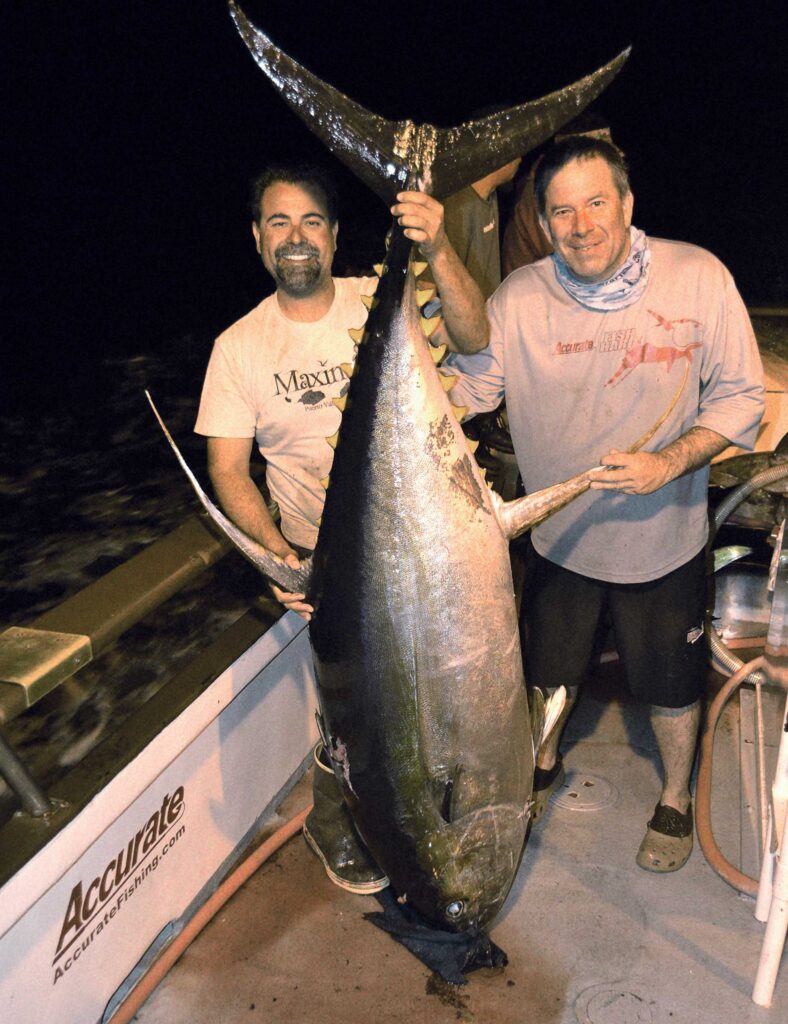SB Television
West Coast Rail-Rod Techniques to Catch Huge Tuna
 Born on the West Coast, rail-rod techniques help anglers exert maximum pressure on tuna while taking the strain off of arms and backs.
Jessica Haydahl Photography
Born on the West Coast, rail-rod techniques help anglers exert maximum pressure on tuna while taking the strain off of arms and backs.
Jessica Haydahl Photography
My first experience with rail-rod fishing occurred far from its origins. The technique was born in the tropics of Mexico, where West Coast long-range sport-fishing boats have used it for decades to beat big, tough yellowfin tuna.
Yet I was indoctrinated aboard my 21-foot center-console by Ben Secrest and Doug Nilson, both from Accurate Fishing, just 15 miles off Dana Point, California, in 2015.
On this midsummer day, we found school upon school of 100-pound-class bluefin tuna tearing up little baitfish, and it did not take long for Nilson to hook one using a small metal jig he cast into the middle of a feeding frenzy. What happened next truly impressed upon me the remarkable effectiveness of rail-rod fishing.
As the fish began its circling vertical battle, Nilson moved forward on the upwind side of the boat, laid the rod foregrip on the bow rail and, while crouched on one knee, went to work.
Meanwhile, I started to prep my GoPro and SLR camera to chronicle the battle, but before I could get things ready, Nilson called for the gaff—two gaffs, in fact. The fish was nearly boatside. He had beat the 100-pound bluefin in under 10 minutes. Secrest and I sunk the gaffs and hauled it aboard.
I have since used and seen rail-rod techniques utilized on even bigger bluefins up to 250 pounds—and the effectiveness always astounds me.
 The idea centers around using the rail as a fulcrum, which turns the rod into
a powerful lever.
Jessica Haydahl Photography
Early Days
The idea centers around using the rail as a fulcrum, which turns the rod into
a powerful lever.
Jessica Haydahl Photography
Early Days
Rail-rod techniques were forged in the heat of battle aboard the vaunted long-range boats based in San Diego—big passenger sport-fishing vessels such as Royal Polaris, Royal Star, Excel, American Angler and others during extended multiday trips down the coast of Baja and beyond.
Big yellowfin tuna represent the primary quarry on many trips aboard these boats that possess relatively high rails and no fighting chairs. Long-range boats often fish on anchor for big tuna, which can require that an angler quickly follow a fish around the boat and over or under the anchor line while dodging fellow anglers. This is difficult while strapped into a fighting harness, but anglers still used harnesses with big reels like 50-wides for many years.
Braid RevolutionThings changed, however, with the advent of braided line, which enabled higher line capacities and, as a result, allowed the use of smaller reels on par with a Shimano Talica 25 two-speed and comparatively lighter rods for big tuna. Harnesses and even rod belts became irrelevant as long-range anglers instead switched to laying the rod on the rail to battle big tuna. The lighter tackle and eschewing a harness also granted anglers greater agility when following a fish around the boat.
As a result, a long-range boat’s tall rail, rather than being viewed as an impediment, has become a tuna angler’s best friend. Crewmembers encourage their long-range fishermen to lay the rod foregrip on the rail. This might go without saying, but rail-rod techniques work only with conventional tackle in which the guides and line run above the rod. Spinning gear is not compatible.
 To help elevate the fulcrum point for rail-rod fishing on private boats, some anglers use devices such as a trident in a gunwale rod holder.
Jessica Haydahl Photography
Gaining Leverage
To help elevate the fulcrum point for rail-rod fishing on private boats, some anglers use devices such as a trident in a gunwale rod holder.
Jessica Haydahl Photography
Gaining Leverage
The rail-rod technique can vary slightly depending on the size of the fish, the power of the rod, and the rail height and configuration. Accurate’s Secrest developed his rail-rod techniques while fishing for cow (over 200-pound) yellowfin tuna on boats out of Puerto Vallarta, Mexico, and has learned as much over the years from the fish he has landed, as well as those that were lost, he says.
“The whole idea centers around using the rail as a fulcrum, which turns the rod into a powerful lever,” Secrest explains. This also takes strain off the angler’s arms and back while exerting maximum pressure on fish. But fighting a tuna on the rail still requires major energy, as well as the need to pay close attention to the fish’s behavior, Secrest advises.
“Every fish acts a little differently, so you have to be ready to lift the rod up and follow the fish or change your location,” he says. “For example, if you are fighting the fish in the bow, you probably will eventually need to move to the stern area when the fish is ready to gaff.”
Arms, Hands and ButtSince the foregrip is on the rail and under tremendous pressure, anglers sometimes can’t hold on there. So, rod and grip positions vary from traditional big-game techniques. On a passenger boat, if you are right-handed, place the rod butt under your left armpit. Put your left hand over the top of the reel (rather than on the rod foregrip) and use your right hand to hold and turn the reel handle. For lefties, do the opposite.
“I sometimes use my left hand to support and stabilize the reel,” says Capt. Brandon Nelson, who hosts charter guests aboard his Yellowfin 32, Lucky B, in pursuit of bluefin tuna and other species off the coast of Southern California. “When fighting a tuna on the rail, you want to semi-crouch with the rod butt under your arm to lift the rod, then stand up and crank line,” Nelson says.
Secrest describes it a bit differently. “Put weight on your ass to pull back on the line and put a bend in the rod,” he explains. “Then stand and wind line onto the reel and repeat.
“You might gain only 2 or 3 inches of line at a time, but the point is to keep the pressure on the fish,” he adds. “You will learn over time how much pressure you can apply as it circles to the outside and how much line you can gain as it makes its inside turn.”
Rod TheoryBoth Nelson and Secrest agree that keeping a deep bend in the rod is critical to beating a big tuna as quickly as possible on the rail. “Don’t point the rod at the fish,” Secrest advises. “Remember that the rod catches the fish, the reel gathers line. So, you want a rod with some bend and need to keep it bent to maintain pressure.”
One of Secrest’s favorite rods for tuna is the 7-foot Accurate Valiant BV-70XXXH model. He matches this to an Accurate ATD Platinum 30T, an open-top reel he loads with 100-pound-test braid for tuna. “Reels like this are easier to handle than big 50s while fighting a fish on the rail,” he points out. “I have caught bluefin over 300 pounds with this gear.”
A Shimano pro staffer, Nelson likes to use a Shimano Talico 25 two-speed, and he removes the harness lugs atop the reel to facilitate the rail-rod technique. Loaded with 100-pound-test braid, the open-top design of the reel also allows Nelson to apply a little extra drag pressure with his hand on the spool when necessary. He matches the reel with a G.Loomis 9080 Pro Offshore 7½-foot XXH rod, with which he has caught bluefin up to 305 pounds.
Another key feature of a rail rod is an extra-thick and long neoprene foregrip to cushion the rod on the rail while battling a fish. The Shimano Terez 72XXH 7-foot-2-inch rail rod, for example, features a thick foregrip that extends forward from the reel nearly 20 inches.
Read Next: Choosing a Slow-Pitch Jigging Rod
 Ben Secrest (right) of Accurate Fishing honed his rail-rod techniques on big yellowfin tuna off Puerto Vallarta, Mexico.
Courtesy Ben Secrest
Rail Height
Ben Secrest (right) of Accurate Fishing honed his rail-rod techniques on big yellowfin tuna off Puerto Vallarta, Mexico.
Courtesy Ben Secrest
Rail Height
The height of the boat rail represents a major factor in rail-rod fishing. On West Coast passenger fishing boats, this dimension is fairly consistent at about 40 inches high around amidships and the aft cockpit. As a result, it is the de facto standard height for most rail-rod fishing.
On private boats, however, rail heights vary considerably, not only from bow to stern, but also from boat to boat. In the opening scenario aboard my 21-foot boat, for example, the bow rail was so low that Accurate’s Nelson needed to kneel down to use it as a fulcrum point, which is not very comfortable.
To help raise the fulcrum point, Nelson has used a trident in the rod holders of his Yellowfin 32, which has worked well for his charter guests over the years. However, a system used to raise the fulcrum point emerged a couple of years ago. A new device known as the RAP—Rail Assist Pipe—is gaining popularity among tuna anglers, according to company owner Joe Russo. It is happening on the West Coast, as well as the East and Gulf coasts, he says.
“The RAP consists of a high-strength stainless-steel pipe with a gimbal base that drops into a gunwale rod holder and locks into the cross pin at the bottom,” Russo says. “At the top of the pipe is a U-shaped cradle that holds the rod and swivels to help follow a tuna as it circles below.”
The pipes are available in models to fit 30-, 15- and zero-degree angled rod holders that are 10 inches deep. Each is offered in three heights—the standard model extends 15 to 16 inches above the gunwale, the Tall Boy adds 21 inches of height, and the new Stubby provides 10 or 12 inches of elevation. The different heights accommodate different gunwale heights, as well as the varying statures of anglers.
“The RAP system is also great for boat owners who don’t want to drag the rod across the rail cap and damage the finish,” Russo has discovered. “There also are some anglers who use spinning gear with the RAP system because it keeps the line from getting pinched under the rod.”
IGFA Controversy
Just in case you’re thinking of pursuing an IGFA record, keep in mind that using rail-rod techniques will disqualify a potential record under the organization’s rules. Some big-game purists might raise an eyebrow at the mention of rail-rod techniques.
At the same time, other anglers question the elitist point of view, given that the use of a fighting chair with a deck hand pivoting the chair to follow a fish is allowed in the IGFA rule book. Perhaps the organization will consider changing its rules with regard to rail-rod techniques in years to come.
In the meantime, rail-rod techniques are gaining acceptance among anglers from coast to coast to coast. And rightly so, as few fish-battling methods have proven as effective when it comes to beating big tuna quicker and with less effort.
The post West Coast Rail-Rod Techniques to Catch Huge Tuna appeared first on Salt Water Sportsman.
- Home
- About Us
- Write For Us / Submit Content
- Advertising And Affiliates
- Feeds And Syndication
- Contact Us
- Login
- Privacy
All Rights Reserved. Copyright , Central Coast Communications, Inc.